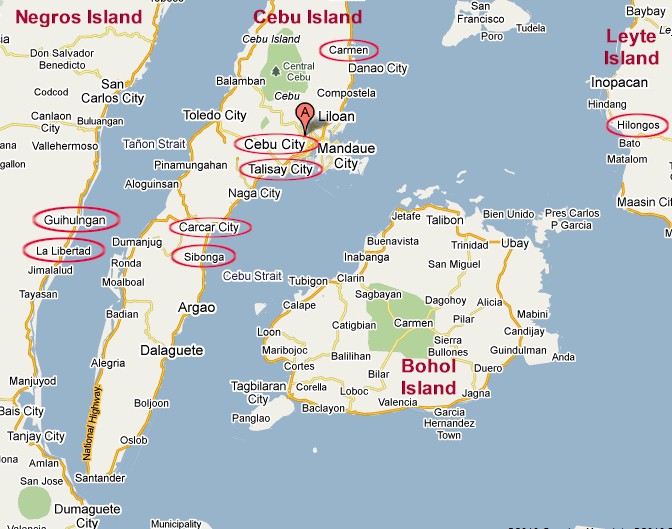Introduction
to
No Scalpel Vasectomy International, Inc. (NSVI)
&
Vasectomy Missions in the Philippines
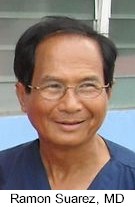 At the American Urological Association Annual
Meeting in Orlando in May 2008, I met Ramon Suarez, MD (Diplomate of the
American Board of Urology) when we both attended a
luncheon meeting of the Society for the Study of Male Reproduction. Ramon is a
Filipino-American doctor who practiced urology for many years in Pennsylvania. He
became fond of Naples, Florida during vacation visits and ultimately retired
there. For many years, he has participated in medical mission trips to his
native country. Given the fact that the Philippines has a population of
90,000,000 distributed among over 7000 islands with a cumulative land area
similar to that of New Mexico, Ramon has recognized a need for family planning
services, despite some resistance from various church and government leaders in
this largely Catholic country. Vasectomy and tubal ligation work particularly
well in population groups who may not always have access to less dependable
alternatives, who may not be able to afford the alternatives, and who may not be
optimally compliant with those alternatives when they are available and provided
without cost. If the Philippine population is equally divided among an 80-year
life expectancy (a stretch, but it makes the math easy), then there are about
1,000,000 people in each age group, 500,000 "couples" in each age group. Which
means that every year, 500,000 couples reach the stage at which they feel
content with the number of children that they already have. If most of the women
are 15 years pre-menopause, then what does the couple do for the next 15 years?
Vasectomy provides an easy and dependable solution, but if only half of those
couples choose vasectomy, that still leaves a workload of 250,000 vasectomies per year
to prevent the unintended pregnancies that routinely occur after couples decide
that they have had enough children to feel fulfilled as parents. Working
full time at 20 locations in Florida, I perform about 2,500 vasectomies per year.
Which means that the Philippines would need 100 energetic vasectomists working
tirelessly to provide the service to just half of the parentally mature couples.
At the American Urological Association Annual
Meeting in Orlando in May 2008, I met Ramon Suarez, MD (Diplomate of the
American Board of Urology) when we both attended a
luncheon meeting of the Society for the Study of Male Reproduction. Ramon is a
Filipino-American doctor who practiced urology for many years in Pennsylvania. He
became fond of Naples, Florida during vacation visits and ultimately retired
there. For many years, he has participated in medical mission trips to his
native country. Given the fact that the Philippines has a population of
90,000,000 distributed among over 7000 islands with a cumulative land area
similar to that of New Mexico, Ramon has recognized a need for family planning
services, despite some resistance from various church and government leaders in
this largely Catholic country. Vasectomy and tubal ligation work particularly
well in population groups who may not always have access to less dependable
alternatives, who may not be able to afford the alternatives, and who may not be
optimally compliant with those alternatives when they are available and provided
without cost. If the Philippine population is equally divided among an 80-year
life expectancy (a stretch, but it makes the math easy), then there are about
1,000,000 people in each age group, 500,000 "couples" in each age group. Which
means that every year, 500,000 couples reach the stage at which they feel
content with the number of children that they already have. If most of the women
are 15 years pre-menopause, then what does the couple do for the next 15 years?
Vasectomy provides an easy and dependable solution, but if only half of those
couples choose vasectomy, that still leaves a workload of 250,000 vasectomies per year
to prevent the unintended pregnancies that routinely occur after couples decide
that they have had enough children to feel fulfilled as parents. Working
full time at 20 locations in Florida, I perform about 2,500 vasectomies per year.
Which means that the Philippines would need 100 energetic vasectomists working
tirelessly to provide the service to just half of the parentally mature couples.
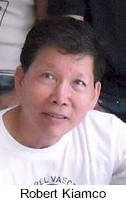 Ramon invited me to join him on his 2010
vasectomy mission. He and friend Robert "Bob" Kiamco, MSME, a
professional engineer,
and their physician wives, Nenita Suarez, MD (Board Certified in Internal
Medicine and Pulmonary Diseases) and Benita Kiamco, MD (Board
Certified in Pediatrics), had formed a not-for-profit organization called No-Scalpel Vasectomy
International (NSV International), incorporated in the state of Pennsylvania in
May 2002. Ramon serves as President, Nenita as Vice-President,
Bob as Chairman of the Board and Director of Missions, and Benita as
Secretary-Treasurer. Through donations from generous supporters, they have been
able to purchase NSV instruments, train local doctors, and provide vasectomy
services free of charge in areas of the Philippines where the need is greatest.
These services are provided (1) year-round by Dr. Joseph Alesna at the
Department of Reproductive Health of Southwestern University College of Medicine
in Cebu City, and (2) during annual vasectomy missions to various cities in the
Philippines (see map below).
Ramon invited me to join him on his 2010
vasectomy mission. He and friend Robert "Bob" Kiamco, MSME, a
professional engineer,
and their physician wives, Nenita Suarez, MD (Board Certified in Internal
Medicine and Pulmonary Diseases) and Benita Kiamco, MD (Board
Certified in Pediatrics), had formed a not-for-profit organization called No-Scalpel Vasectomy
International (NSV International), incorporated in the state of Pennsylvania in
May 2002. Ramon serves as President, Nenita as Vice-President,
Bob as Chairman of the Board and Director of Missions, and Benita as
Secretary-Treasurer. Through donations from generous supporters, they have been
able to purchase NSV instruments, train local doctors, and provide vasectomy
services free of charge in areas of the Philippines where the need is greatest.
These services are provided (1) year-round by Dr. Joseph Alesna at the
Department of Reproductive Health of Southwestern University College of Medicine
in Cebu City, and (2) during annual vasectomy missions to various cities in the
Philippines (see map below).
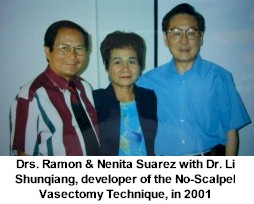 Dr. Suarez was one of the first American
urologists to perform the no-scalpel vasectomy technique. After hearing about
the new technique, developed in China, at an American Urological Association
meeting in 1989, Dr. Suarez took it upon himself to go right to the source. He
traveled to China in September 1990 and was trained and certified by Dr. Li
Shunqiang, the inventor of the NSV instruments and developer of the technique.
Upon his return to Pennsylvania, he trained local physicians and urology
residents in South-central Pennsylvania and at Pennsylvania State University
College of Medicine Department of Surgery at the Milton S. Hershey Medical
Center in Hershey, Pennsylvania. Eleven years later, during a second visit to
China in 2001, Dr. Suarez visited Dr. Li to express his appreciation for the
technique that had by now become an American standard.
Dr. Suarez was one of the first American
urologists to perform the no-scalpel vasectomy technique. After hearing about
the new technique, developed in China, at an American Urological Association
meeting in 1989, Dr. Suarez took it upon himself to go right to the source. He
traveled to China in September 1990 and was trained and certified by Dr. Li
Shunqiang, the inventor of the NSV instruments and developer of the technique.
Upon his return to Pennsylvania, he trained local physicians and urology
residents in South-central Pennsylvania and at Pennsylvania State University
College of Medicine Department of Surgery at the Milton S. Hershey Medical
Center in Hershey, Pennsylvania. Eleven years later, during a second visit to
China in 2001, Dr. Suarez visited Dr. Li to express his appreciation for the
technique that had by now become an American standard.
History of No Scalpel Vasectomy International, Inc.
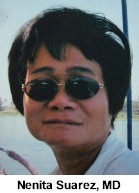
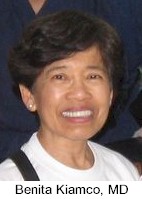 As a medical student in Cebu City in the
early 1960's, Dr. Suarez had met Robert "Bob" Kiamco when they were dating the women
who would ultimately become their wives. They became lifelong friends and met
regularly after Ramon emigrated to Pennsylvania and Robert emigrated to Chicago.
In 2000, Bob and his wife
Benita
joined Filipino-American physician friends in their hometown of Chicago on a
medical mission to the Philippines. In Davao, Mindanao, Bob was impressed with a
seemingly endless line of patients waiting for care and realized that medical
manpower would always be woefully understaffed if they could not address the
population explosion. Later in the year 2000, and a decade after Dr. Suarez had
developed an appreciation for the ease and simplicity of NSV, Bob met Ramon at a
conference of the Bisaya Medical Association (BMA) (Ramon was on the board and
is now the President-elect) in Chicago. They decided that it was time for an
independent mission dedicated to family planning through vasectomy. They recognized
the key role that NSV could serve in addressing the need for better family
planning in developing countries. Using their own personal funds, the two men
and their physician wives organized the first-ever vasectomy mission to the
Philippines in 2001. As point man, Bob would use his organizational
skills to disseminate information and educate the Filipino people about the
personal, social, and economic benefits of NSV, not to mention the myriad health
benefits including reduced infant and maternal mortality rates, reduced illegal
abortion rates (in a country where abortion is illegal), and reduced rates of
infant abandonment. (In the Philippines, as in many other developing countries
with a shortage of medical services, the main cause of death in women ages 15-35
is pregnancy and delivery.) Ramon would follow with his surgical skills, surprising
Filipino men with the ease and simplicity of NSV.
As a medical student in Cebu City in the
early 1960's, Dr. Suarez had met Robert "Bob" Kiamco when they were dating the women
who would ultimately become their wives. They became lifelong friends and met
regularly after Ramon emigrated to Pennsylvania and Robert emigrated to Chicago.
In 2000, Bob and his wife
Benita
joined Filipino-American physician friends in their hometown of Chicago on a
medical mission to the Philippines. In Davao, Mindanao, Bob was impressed with a
seemingly endless line of patients waiting for care and realized that medical
manpower would always be woefully understaffed if they could not address the
population explosion. Later in the year 2000, and a decade after Dr. Suarez had
developed an appreciation for the ease and simplicity of NSV, Bob met Ramon at a
conference of the Bisaya Medical Association (BMA) (Ramon was on the board and
is now the President-elect) in Chicago. They decided that it was time for an
independent mission dedicated to family planning through vasectomy. They recognized
the key role that NSV could serve in addressing the need for better family
planning in developing countries. Using their own personal funds, the two men
and their physician wives organized the first-ever vasectomy mission to the
Philippines in 2001. As point man, Bob would use his organizational
skills to disseminate information and educate the Filipino people about the
personal, social, and economic benefits of NSV, not to mention the myriad health
benefits including reduced infant and maternal mortality rates, reduced illegal
abortion rates (in a country where abortion is illegal), and reduced rates of
infant abandonment. (In the Philippines, as in many other developing countries
with a shortage of medical services, the main cause of death in women ages 15-35
is pregnancy and delivery.) Ramon would follow with his surgical skills, surprising
Filipino men with the ease and simplicity of NSV.
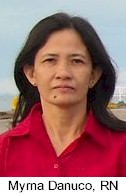
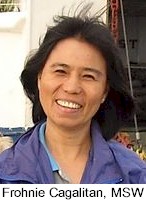 That
first mission, in 2001,
was in
Cebu at Sacred Heart Hospital, owned by Southwestern University College of
Medicine, where Ramon and Bob's wife Benita earned their medical degrees. Dr.
Lydia Aznar Alfonso, the Director of Sacred Heart Hospital, was a personal
friend and very receptive to the idea of a vasectomy mission. (In the 70's, she
had spearheaded family planning so enthusiastically in the Philippines that she
was excommunicated from the Catholic Church.) She promoted awareness of both NSV
and the pending mission of these two Americans, she volunteered free use of the
hospital facilities, and arranged the assistance of Registered Nurse Myrna Danuco to help Bob counsel and organize the patients. When
Frohnie Cagalitan,
MSW, who had dedicated so much of her professional career to Family planning,
heard about the NSV mission, she volunteered her services and has been with
every mission since the first.
That
first mission, in 2001,
was in
Cebu at Sacred Heart Hospital, owned by Southwestern University College of
Medicine, where Ramon and Bob's wife Benita earned their medical degrees. Dr.
Lydia Aznar Alfonso, the Director of Sacred Heart Hospital, was a personal
friend and very receptive to the idea of a vasectomy mission. (In the 70's, she
had spearheaded family planning so enthusiastically in the Philippines that she
was excommunicated from the Catholic Church.) She promoted awareness of both NSV
and the pending mission of these two Americans, she volunteered free use of the
hospital facilities, and arranged the assistance of Registered Nurse Myrna Danuco to help Bob counsel and organize the patients. When
Frohnie Cagalitan,
MSW, who had dedicated so much of her professional career to Family planning,
heard about the NSV mission, she volunteered her services and has been with
every mission since the first.
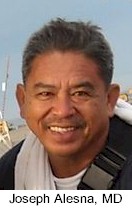 During that first mission in 2001, Ramon
performed nearly 100 vasectomies, and during a second mission in February 2002,
he performed over 100 vasectomies. The modus operandi was established, but
Ramon, Bob, Nenita, and Benita needed a broader base of support. So with the help of a carefully
chosen accountant and attorney, they formed, in May 2002, a non-profit charitable
organization under 501(C)(3) of the Internal Revenue Code and called it No-Scalpel Vasectomy International, Inc. (NSVI), so that they could formally
receive the donations of enthusiastic supporters. In October 2002 in response to
these two successful missions, EngenderHealth provided a grant of $30,000 to
Sacred Heart Hospital to remodel a procedure room into a designated NSV room. Through funding from the
United Nations Population Development Program, NSVI was able to invite Dr. Li
and his team from China in 2003 to conduct the first-ever Philippine training
seminar for NSV, with presentations and missions at three sites on Cebu Island
(Cebu City, Carmen, and Minglanilla), contributing to the expert training of
nearly 20 vasectomists. One of these doctors was Joseph Alesna, M.D., an
independent-minded pediatric surgeon, overwhelmed by a workload that gave him a
special appreciation for the importance of a manageable family size. With NSVI
on all subsequent missions, he performs not only NSV, but volunteers his other
general surgical skills to complement the needs of NSV patients when the
occasions arise.
During that first mission in 2001, Ramon
performed nearly 100 vasectomies, and during a second mission in February 2002,
he performed over 100 vasectomies. The modus operandi was established, but
Ramon, Bob, Nenita, and Benita needed a broader base of support. So with the help of a carefully
chosen accountant and attorney, they formed, in May 2002, a non-profit charitable
organization under 501(C)(3) of the Internal Revenue Code and called it No-Scalpel Vasectomy International, Inc. (NSVI), so that they could formally
receive the donations of enthusiastic supporters. In October 2002 in response to
these two successful missions, EngenderHealth provided a grant of $30,000 to
Sacred Heart Hospital to remodel a procedure room into a designated NSV room. Through funding from the
United Nations Population Development Program, NSVI was able to invite Dr. Li
and his team from China in 2003 to conduct the first-ever Philippine training
seminar for NSV, with presentations and missions at three sites on Cebu Island
(Cebu City, Carmen, and Minglanilla), contributing to the expert training of
nearly 20 vasectomists. One of these doctors was Joseph Alesna, M.D., an
independent-minded pediatric surgeon, overwhelmed by a workload that gave him a
special appreciation for the importance of a manageable family size. With NSVI
on all subsequent missions, he performs not only NSV, but volunteers his other
general surgical skills to complement the needs of NSV patients when the
occasions arise.
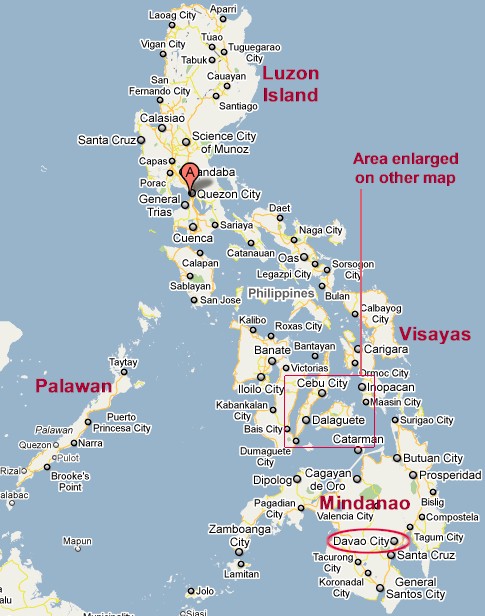 |
|
|||||||||||||||||||||||||||||||||||
|
|
||||||||||||||||||||||||||||||||||||
NSVI now has over 100 donors throughout the US.
Contributions to NSV International, Inc. are used for the following:
| 1. | To pay Dr. Alesna for his year-round services on a per case basis. |
| 2. | To purchase and maintain the instruments and supplies used by Dr. Alesna. |
| 3. | To reimburse the facility where Dr. Alesna provides services (Sacred Heart Hospital of Southwest University). |
| 4. | To pay nurses and social workers to provide patient education and public awareness of vasectomy, including brochures printed in local dialects, for both year-round services and annual missions. |
| 5. | Transportation, board and lodging for mission surgeons, nurses, and helpers. |
| 6. | To provide honorariums for mission nurses and helpers. |
| 7. | To reimburse vasectomy patients for meals, transportation, and loss of family income for the day of their vasectomies and the following day of recuperation. |
| 8. | To provide medications (antibiotics and analgesics) to vasectomy patients. |
| 9. | To purchase disposables for vasectomy mission days: surgeons gloves, antiseptics, anesthetics, sterile drapes, bandages, etc. |
If you would like to contribute to
NSVI and learn more about the activities of the organization, please visit the
NSVI website. the site is
still undergoing construction and improvements, but the "Donate
Now" page is fully functional.
Thank you.
If you would like to read about my 2010 trip to the Philippines with NSVI, start here.
